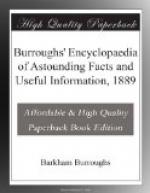This strange action is called “capillary,” from the resemblance the minute tubes bear to a hair, the Latin of which is capillus. It is, moreover, singular that the absorption of the water takes place with great force. If a dry sponge be enclosed tightly in a vessel, it will expand when wetted, with sufficient force to burst it, unless very strong.
London Water Supply.—The quantity of water consumed in London amounts to about 145,000,000 gallons a day. If this quantity could be collected together, it would form a lake 700 yards long, 200 wide, and with a uniform depth of 20 feet.
A Protection for Embankments.—Engineers often have considerable trouble with the loose soil of newly-made embankments, so apt to slip or be washed away before they are covered with vegetation. According to a French railway engineer, the best plan is to sow the banks with the double poppy. Several months elapse before grasses and clovers develop their feeble roots, but the double poppy germinates in a few days, and in a fortnight has grown sufficiently to afford some protection to the slope, while at the end of three or four months the roots, which are ten or twelve inches in length, are found to have interlaced so as to retain the earth far more firmly than those of any grass or grain. Although the double poppy is an annual, it sows itself after the first year.
A Cheap Concrete.—A kind of concrete made without cement is composed of 8 parts of sand, gravel and pebbles, 1 part of burnt and powdered common earth, 1 part of pulverized clinkers and cinders, and 1-1/2 parts of unslacked hydraulic lime. These materials are thoroughly incorporated while dry into a homogeneous mixture, which is then wetted up and well beaten. The result of this is a hard and solid mass, which sets almost immediately, becoming exceedingly strong after a few days. It may be made still stronger by the addition of a small proportion—say 1 part—of cement.
Marking Tools.—To mark tools, first coyer the article to be marked with a thin coating of tallow or beeswax, and with a sharp instrument write the name in the tallow. Clear with a feather, fill the letters with nitric acid, let it remain from one to ten minutes, then dip in water and run off, and the marks will be etched into the steel or iron.
How to Prevent Chisel Handles Splitting.—All carpenters know how soon the butt-end of chisel handles split when daily exposed to the blow of a mallet or hammer. A remedy suggested by a Brooklyn man consists simply of sawing or cutting off the round end of the handle so as to make it flat, and attaching by a few nails on the top of it two discs of sole leather, so that the end becomes similar to the heel of the boot. The two thicknesses of leather will prevent all further splitting, and if, in the course of time, they expand and overlap the wood of the handle, they are simply trimmed off all around.




